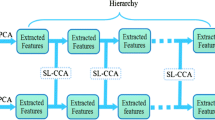Abstract
In this paper, we propose a novel framework for ASD diagnosis using structural magnetic resonance imaging (MRI). Our method deals explicitly with the distributional differences of gray matter (GM) and white matter (WM) features extracted from MR images. We project linearly the GM and WM features onto a canonical space where their correlations are mutually maximized. In this canonical space, features that are highly correlated with the class labels are selected for ASD diagnosis. In addition, graph matching is employed to preserve the geometrical relationships between samples when projected onto the canonical space. Our evaluations based on a public ASD dataset show that the proposed method outperforms all competing methods on all clinically important measures in differentiating ASD patients from healthy individuals.





Similar content being viewed by others
References
Amaral D. G., Schumann C. M., & Nordahl C. W. (2008). Neuroanatomy of autism. Trends in Neurosciences, 31, 137–145.
Boddaert N., Chabane N., Gervais H., Good C., Bourgeois M., Plumet M., Barthelemy C., Mouren M., Artiges E., & Samson Y. (2004). Superior temporal sulcus anatomical abnormalities in childhood autism: a voxel-based morphometry MRI study. NeuroImage, 23, 364–369.
Brambilla P., Hardan A., di Nemi S. U., Perez J., Soares J. C., & Barale F. (2003). Brain anatomy and development in autism: review of structural MRI studies. Brain Research Bulletin, 61, 557–569.
Chai K. M. A., Williams C. K., Klanke S., & Vijayakumar S. (2008). Multi-task gaussian process learning of robot inverse dynamics. Advances in Neural Information Processing Systems, 265-272.
Chen X., Pan W., Kwok J. T., & Carbonell J. G. (2009). Accelerated gradient method for multi-task sparse learning problem. In 2009. ICDM'09. Ninth IEEE International Conference on Data Mining. IEEE (pp. 746–751).
Cortes C., & Vapnik V. (1995). Support-vector networks. Machine Learning, 20, 273–297.
Evgeniou A., & Pontil M. (2007). Multi-task feature learning. Advances in Neural Information Processing Systems, 19, 41.
Friedman, J., Hastie, T., Tibshirani, R., 2010. A note on the group lasso and a sparse group lasso. arXiv preprint arXiv:1001.0736.
Geschwind D. H., & Levitt P. (2007). Autism spectrum disorders: developmental disconnection syndromes. Current Opinion in Neurobiology, 17, 103–111.
Guilmatre A., Dubourg C., Mosca A.-L., Legallic S., Goldenberg A., Drouin-Garraud V., Layet V., Rosier A., Briault S., & Bonnet-Brilhault F. (2009). Recurrent rearrangements in synaptic and neurodevelopmental genes and shared biologic pathways in schizophrenia, autism, and mental retardation. Archives of General Psychiatry, 66, 947–956.
Hardoon D., Szedmak S., & Shawe-Taylor J. (2004). Canonical correlation analysis: An overview with application to learning methods. Neural Computation, 16, 2639–2664.
Jalali A., Sanghavi S., Ruan C., & Ravikumar P. K. (2010). A dirty model for multi-task learning. Advances in Neural Information Processing Systems, 964-972.
Jie B., Zhang D., Cheng B., & Shen D. (2013). Manifold regularized multi-task feature selection for multi-modality classification in Alzheimer’s disease. Medical Image Computing and Computer-Assisted Intervention–MICCAI 2013 (pp. 275–283). Springer.
Kakade S. M., & Foster D. P. (2007). Multi-view regression via canonical correlation analysis. Learning Theory (pp. 82–96). Springer.
Lim K. O., & Pfefferbaum A. (1989). Segmentation of MR brain images into cerebrospinal fluid spaces, white and gray matter. Journal of Computer Assisted Tomography, 13, 588–593.
Liu F., Wee C.-Y., Chen H., & Shen D. (2014). Inter-modality relationship constrained multi-modality multi-task feature selection for Alzheimer’s disease and mild cognitive impairment identification. NeuroImage, 84, 466–475.
Liu J., Ji S., & Ye J. (2009). Multi-task feature learning via efficient l 2, 1-norm minimization. Proceedings of the Twenty-Fifth conference on uncertainty in artificial intelligence (pp. 339–348). AUAI Press.
Shen D., & Davatzikos C. (2002). HAMMER: hierarchical attribute matching mechanism for elastic registration. IEEE Transactions on Medical Imaging, 21, 1421–1439.
Tibshirani R. (1996). Regression shrinkage and selection via the lasso. Journal of the Royal Statistical Society. Series B Methodological), 267-288.
Wang Y., Nie J., Yap P.-T., Shi F., Guo L., & Shen D. (2011). Robust deformable-surface-based skull-stripping for large-scale studies. Medical Image Computing and Computer-Assisted Intervention–MICCAI 2011 (pp. 635–642). Springer.
Wee C.-Y., Yap P.-T., Zhang D., Wang L., & Shen D. (2014a). Group-constrained sparse fMRI connectivity modeling for mild cognitive impairment identification. Brain Structure and Function, 219, 641–656.
Wee C. Y., Wang L., Shi F., Yap P. T., & Shen D. (2014b). Diagnosis of autism spectrum disorders using regional and interregional morphological features. Human Brain Mapping, 35, 3414–3430.
Wing L., & Gould J. (1979). Severe impairments of social interaction and associated abnormalities in children: epidemiology and classification. Journal of Autism and Developmental Disorders, 9, 11–29.
Xue Y., Liao X., Carin L., & Krishnapuram B. (2007). Multi-task learning for classification with Dirichlet process priors. Journal of Machine Learning Research, 8, 35–63.
Zhang D., Shen D., & Alzheimer’s disease Neuroimaging, I. (2012a). Multi-modal multi-task learning for joint prediction of multiple regression and classification variables in Alzheimer's disease. NeuroImage, 59, 895–907.
Zhang D., Shen D., & Alzheimer's Disease Neuroimaging I. (2012b). Predicting future clinical changes of MCI patients using longitudinal and multimodal biomarkers. PloS One, 7, e33182.
Zhang T., Ghanem B., Liu S., & Ahuja N. (2013). Robust visual tracking via structured multi-task sparse learning. International Journal of Computer Vision, 101, 367–383.
Zhu X., Suk H.-I., & Shen D. (2014). Multi-modality canonical feature selection for Alzheimer's disease diagnosis. In 17th International Conference on Medical Image Computing and Computer-Assisted Intervention, MICCAI 2014, September 14, 2014 - September 18, 2014. (pp. 162–169). Boston: Springer Verlag.
Acknowledgments
This work was supported partially by NIH grant (EB006733, EB008374, EB009634, MH100217, AG041721, AG042599), and National Natural Science Foundation of China (NSFC) Grants (61473190, 81471743).
Conflict of interest
Liye Wang, Chong-Yaw Wee, Xiaoying Tang, Pew-Thian Yap, and Dinggang Shen declare that they have no conflicts of interest.
Author information
Authors and Affiliations
Corresponding author
Rights and permissions
About this article
Cite this article
Wang, L., Wee, CY., Tang, X. et al. Multi-task feature selection via supervised canonical graph matching for diagnosis of autism spectrum disorder . Brain Imaging and Behavior 10, 33–40 (2016). https://doi.org/10.1007/s11682-015-9360-1
Published:
Issue Date:
DOI: https://doi.org/10.1007/s11682-015-9360-1




